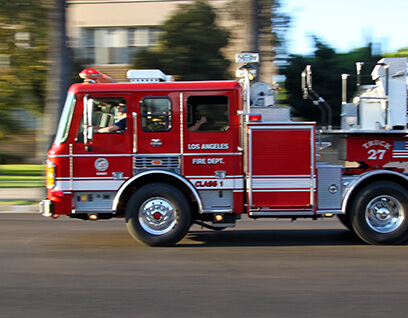
Drive safely.
Drive responsibly.
Drive professionally.
Every driver has to deal with emergency vehicles on the road, and in most states the law is very specific as to what a driver must do when an emergency vehicle is encountered. As professional drivers we are concerned with the law, but we are also concerned with what is the safe, responsible and professional way to handle these situations. First keep in mind that these emergency vehicles are out there doing a job—to “protect and serve” the motoring public—and it is our responsibility to look out for their welfare and assist them in any way possible in their jobs. Law enforcement, ambulances and EMT, firefighting vehicles, wreckers and road construction crew vehicles all need our help to perform their jobs safely.
Yielding to emergency vehicles.
In almost all jurisdictions, anytime you see the approach of an emergency vehicle with either audible and/or visual warning signals in operation you must:
- immediately yield the right-of-way
- drive to the right-hand edge of the curb or roadway, clear of any intersection
- check your mirrors, give proper signals and move to the side of the road only when it is safe to do so
- as soon as you stop, activate your emergency flashers and leave them on until you are ready to move back into traffic
- remain on the side of the roadway until the emergency vehicle has passed
These steps have to be done very carefully, especially on multi-lane roads because of other traffic around you.
Move over laws.
Most states also have laws in place covering what to do when passing emergency vehicles that are stopped or parked on the shoulder of the road. The laws are very simple – when you see an emergency vehicle stopped with the emergency lights activated you must “proceed with due caution.” This is the legal term for passing safely without putting yourself or the emergency vehicle (and driver) in danger. You are also required to move to a lane “not adjacent to that of the emergency vehicle,” when it is safe to do so considering road and traffic conditions and when on a road having two or more lanes in the same direction. Alternatively, you may proceed with caution by reducing the speed of your vehicle to the point that you can pass the emergency vehicle safely.
Unfortunately, every year we have police officers and other emergency response personnel fatalities or injuries in these types of collisions because drivers do not exercise good judgment and safe driving. Many states have increased fines and penalties for these violations. In Tennessee, the penalty for violating the “move over” law is currently a $500 fine and 30 days in jail. The Tennessee Commissioner of Safety said it best in a news conference stating, “No fine will ever compare to the burden of knowing you killed or disabled someone because you didn’t move over or slow down.”
Knowing and obeying the safety rules and regulations comes back to driving safely. It requires responsible driving and understanding that no matter what is going on around us, it is our individual responsibility to control our vehicle and minimize risks on the road.
In conclusion:
- Drive as a professional
- Realize that you have the skill, knowledge and experience
- Maintain and exercise professionalism at all times, especially when dealing with emergency vehicles
The information contained in this report was obtained from sources which, to the best of the writer’s knowledge, are authentic and reliable. Arthur J. Gallagher & Co. makes no guarantee of results and assumes no liability in connection with either the information herein contained, or the safety suggestions herein made. Moreover, it cannot be assumed that every acceptable safety procedure is contained herein, or that abnormal or unusual circumstances may not warrant or require further or additional procedures.
